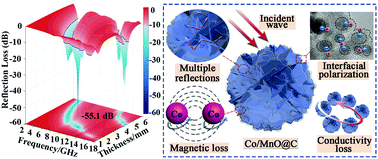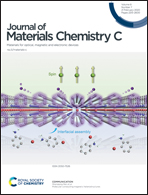Bimetal oxide-derived flower-like heterogeneous Co/MnO@C composites with synergistic magnetic–dielectric attenuation for electromagnetic wave absorption†
Abstract
Multiple component composites are highly desirable for the fabrication of electromagnetic wave absorbers. However, rational configuration of materials and their structural design still remain a big challenge. Herein, magnetic–dielectric Co/MnO@C composites were fabricated through the reduction of Co/Mn bimetal oxides with carbon. In the meantime, a thin layer of carbon was formed on the derived Co/MnO leading to the ternary structure. Electron microscopy analysis elaborates a flower-like morphology with an average size of 1.5 μm, as well as the formation of nanoscale Co and MnO particles and a carbon layer. It is found that the magnetic properties, conductivity and electromagnetic parameters were readily manipulated by the Co proportion, with the purpose of achieving favorable impedance matching and attenuation performance. Accordingly, the Co/MnO@C composites show a remarkable electromagnetic wave absorption performance. Notably, the composites obtained with the weight percentage ratio of Co and MnO of about 2 : 1 exhibit an optimal reflection loss value of −55.3 dB with a thickness of 2.4 mm and the effective absorption bandwidth (7.4–12.0 GHz) covers the whole X band. Our study provides a facile method for preparing homogeneous magnetic–dielectric composite absorbers, and reveals the effect of electromagnetic parameters on the absorption performance with the variation of Co proportion.



 Please wait while we load your content...
Please wait while we load your content...